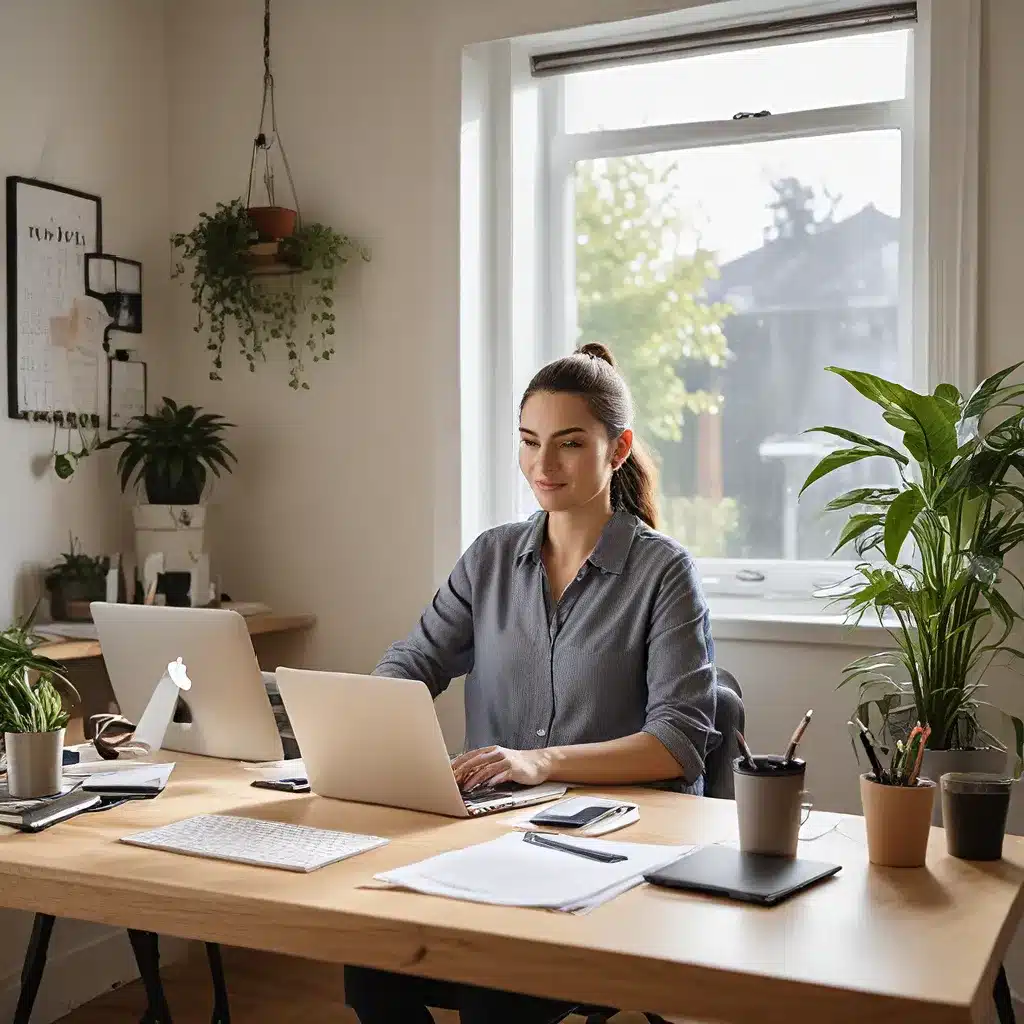
Crafting the Ideal Workspace: A Scientific Approach
As someone who has spent countless hours hunched over a desk, staring at a screen, I know all too well the challenges of maintaining productivity and focus in a work-from-home environment. But what if I told you that the secret to unlocking your full potential lies not in sheer willpower, but in strategically arranging your physical workspace?
Recent studies have revealed that the key to boosting workplace productivity isn’t just about working harder – it’s about working smarter. By leveraging the latest scientific insights, we can create work environments that cater to our natural neurological inclinations, empowering us to achieve new levels of focus, creativity, and overall performance.
Harnessing the Power of Light
Let’s start with the most fundamental element of your workspace: lighting. You see, our brain and body operate on a delicate circadian rhythm, and the quality and timing of the light we’re exposed to can have a profound impact on our cognitive state.
In the early hours of the day, during that initial phase of our 24-hour cycle, bright overhead lighting is your best friend. These luminous cues trigger the release of neurotransmitters like dopamine and norepinephrine, putting your brain into a heightened state of alertness and priming you for detailed, analytical work.
But as the day wanes on, you’ll want to gradually shift towards softer, warmer tones. Dimming the lights and shifting towards yellow hues can help transition your brain into a more relaxed, creative mode – perfect for tackling those abstract, big-picture challenges.
And if you find yourself burning the midnight oil, be mindful of the lighting. Harsh blue-tinged light could severely deplete your melatonin levels, playing havoc with your sleep-wake cycle. Instead, opt for a subtle glow to keep you focused, without disrupting your circadian rhythms.
The Science of Visual Focus
But lighting is just the beginning. Did you know that the positioning of your screen or work materials can also have a significant impact on your productivity? It turns out our visual system is intricately connected to the areas of the brain responsible for focus and attention.
“When we are looking down below the level of our nose, we are essentially decelerating our alertness,” explains neuroscientist Andrew Huberman. “Whereas when we look straight ahead or in particular when we look up, we are increasing our level of alertness.”
So rather than hunching over a laptop or phone, try to position your work at eye level or even slightly above. This simple adjustment can help activate the neural circuits that govern focus and cognitive control, making it easier to stay engaged and on-task.
And if you really want to take it to the next level, consider embracing the “cathedral effect.” Research has shown that working in environments with higher ceilings (or at least the illusion of expansive space) can actually prime your brain for more abstract, creative thinking. Conversely, lower-ceiling spaces tend to facilitate more detailed, analytical work.
The Power of Movement and Sound
But wait, there’s more! Your workspace optimization shouldn’t stop at lighting and visual cues. Movement and sound can also play a crucial role in shaping your cognitive performance.
Studies have found that incorporating physical activity – whether it’s a treadmill desk, a stationary bike, or even just regular standing breaks – can boost attention, cognitive control, and certain types of memory. The key seems to be the way these movements activate the brain’s “central pattern generators,” releasing a cascade of neurotransmitters that heighten alertness and focus.
And the auditory realm holds its own secrets. While you’ll want to steer clear of droning, monotonous sounds like white noise or air conditioning hums (which can actually impair cognitive function), strategic use of binaural beats at specific frequencies may offer a cognitive edge.
“Peer-reviewed research has shown that 40-hertz binaural beats can enhance memory, improve reaction times, and boost verbal recall,” says Huberman. “The mechanism seems to be related to the way these beats influence dopamine transmission in the brain.”
So don’t be afraid to experiment with different soundscapes, just be mindful of what your brain responds best to.
Embracing the Dynamic Workspace
Of course, no one-size-fits-all solution exists. The beauty of optimizing your workspace lies in the flexibility to adapt to your unique needs and preferences. Perhaps you thrive in a cozy, low-ceilinged nook for your analytical tasks, but then shift to a more open, airy environment when it’s time to tap into your creative juices.
And let’s not forget the importance of managing interruptions. While we may crave social interaction, constant disruptions can be the bane of productivity. Consider adopting strategies like strategic body positioning or even the occasional tech-free hideaway to create the focused oasis you need.
Remember, the pursuit of productivity is not a rigid formula, but an ongoing exploration. By staying attuned to the latest scientific insights and experimenting with different workspace arrangements, you can unlock your true potential and transform your work-from-home experience.
So go forth, optimize your space, and watch as your focus, creativity, and overall performance soar to new heights. The key to unlocking your full potential may just be a matter of rearranging your surroundings.
















